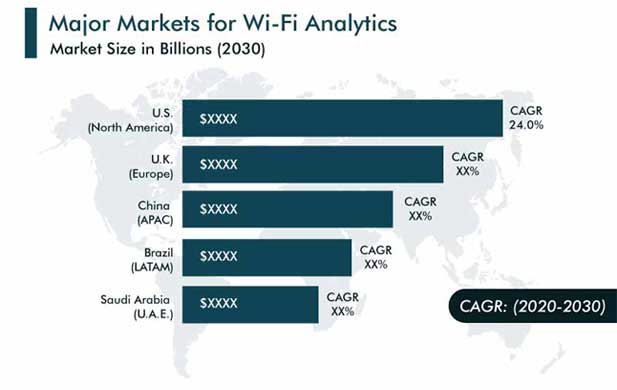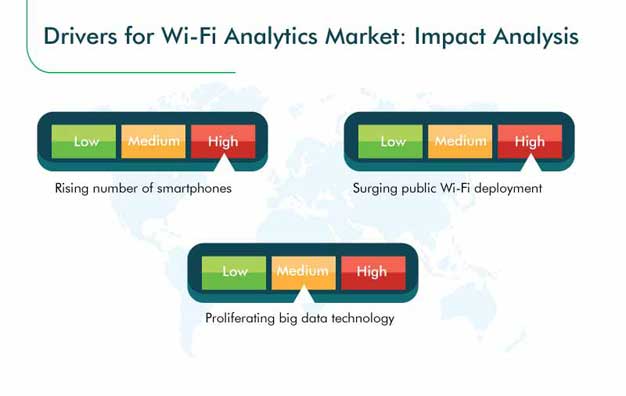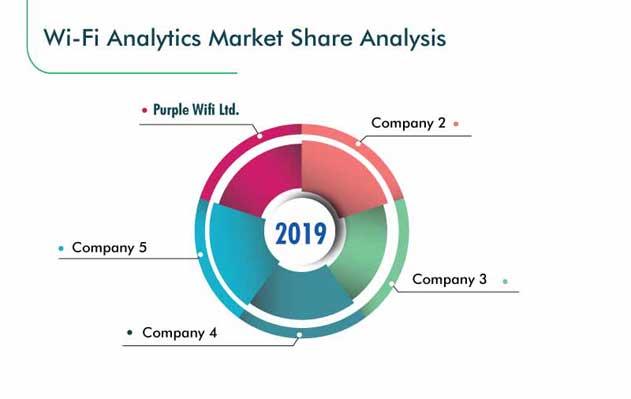Report Code: 12035 | Available Format: PDF | Pages: 200
Wi-Fi Analytics Market Research Report: By Component (Solutions, Services), Application (Wi-Fi Presence Analytics, Wi-Fi Marketing Analytics), Deployment (On-Premises, Cloud), End Use (Smart Infrastructure, Retail, Hospitality, Sports and Entertainment, Transportation, Healthcare) - Global Industry Analysis and Growth Forecast to 2030
- Report Code: 12035
- Available Format: PDF
- Pages: 200
- Report Description
- Table of Contents
- Market Segmentation
- Request Free Sample
Wi-Fi Analytics Market Overview
Valued at $5,210.0 million in 2019, the global Wi-Fi analytics market size is projected to witness a CAGR of 24.2% during the forecast period (2020–2030). The growing penetration of smartphones, surging public Wi-Fi deployment rate, and proliferation of the big data technology are some of the key factors driving the growth of the Wi-Fi analytics industry.
Wi-Fi analytics involves the use of a Wi-Fi network in order to collect data from devices that are equipped with the Wi-Fi technology, such as smartphones and laptops. The data collected includes comprehensive information on the device behavior and trends, both, physically within the space served by the Wi-Fi network, as well as the activity performed via the Wi-Fi internet connection.
The growth of the Wi-Fi analytics market will be hampered in 2020, owing to the global lockdown scenario due to coronavirus disease (COVID-19). Several factors, primarily the closure of shopping malls, restaurants, sports centers, hotels, and other public areas, will restrict the market growth and reduce the demand for Wi-Fi analytics solutions across the globe. However, the industry is projected to experience a revival in its growth in the coming years, due to the rising need of organizations to increase their revenue and counter the damages they suffered due to the COVID-19 crisis. Furthermore, the integration of advanced technologies, such as artificial intelligence (AI) and internet of things (IoT), will further boost the Wi-Fi analytics market in the coming years.

Segmentation Analysis
Solutions are Larger Component Category in Industry
In 2019, the solutions category accounted for larger size in the Wi-Fi analytics market, on the basis of component. These days, businesses are redefining their user experience, empowered by the increased capabilities of accessing online behavioral data and targeted marketing. Restaurants, retail stores, sports arenas, and other businesses are finding ways to further understand and engage with their customers, while they visit. Businesses, through Wi-Fi analytics solutions, predict customer behavior, improve customer experience, and remarket their offerings effectively. Such benefits help the businesses understand visitor trends and upgrade their offerings, to expand their customer base and drive future performance strategies.
Wi-Fi Marketing Analytics is Expected to be Faster-Growing Application Category during Forecast Period
The Wi-Fi marketing analytics category, based on application, is projected to attain faster growth during the forecast period, in the Wi-Fi analytics market. Wi-Fi analytics solutions enable businesses to gather customers’ personal details, such as name, age, gender, and contact details, from their login splash page. The collected information helps businesses create heavily-targeted marketing campaigns, in order to engage with the customer and increase their customer base. By integrating Wi-Fi analytics solutions, businesses can gather customer feedback, run promotions, and accordingly upgrade their marketing strategies.
On-Premises Deployment Category Dominated Market during Historical Period
The on-premises category, on the basis of deployment, accounted for larger market size in the Wi-Fi analytics market during the historical period (2014–2019). Under this deployment mode, the Wi-Fi analytics solutions are integrated on local servers and run on computers at the location of the client/business. The businesses can access their gathered data internally, through a local server, and also have complete control over their information technology (IT) infrastructure. This method of the collection and storage of data on the local server makes the business carefree about its security.
In 2019, Smart Infrastructure Generated Highest Revenue in Market
The smart infrastructure category, among all end users, dominated the Wi-Fi analytics market during the historical period, including 2019. Wi-Fi analytics solutions provide insights to the regulatory bodies of the cities, on how people in the city are navigating through physical spaces and during busy times and days. In addition, they also help evaluate how long people are dwelling in high-traffic areas. By implementing real-time Wi-Fi analytics solutions, smart cities are upgrading their operations and citizen engagement. With access to traffic heat maps, urban planners are more-efficiently strategizing advancements in the traffic system and planning public transportation upgrades, accordingly.
Geographical Outlook
North America Was Largest Regional Market
Globally, North America was the largest region in the Wi-Fi analytics market in 2019. The region is home to several Wi-Fi analytics solution vendors, such as Cloud4Wi Inc., Cisco Systems Inc., Yelp Inc., and GoZone WiFi LLC, which results in a higher adoption of the technology here. Furthermore, the high financial stability of the two countries in the region has enabled them to widely adopt advanced technologies, such as IoT, AI, and big data.
Asia-Pacific (APAC) Expected to be Fastest Growing Regional Market
Asia-Pacific (APAC) is projected to be the fastest-growing regional category in the market in the coming years. Among all the countries in the region, China holds the largest market share, majorly due to the fact that the country is an early adopter of the latest technologies and has a huge population that operates smartphones and accesses the internet. In the first quarter of 2020, there were around 845 million internet users in China. The Indian market in the region is projected to attain the fastest growth during the forecast period. According to the Associated Chambers of Commerce of India (ASSOCHAM), the number of smartphone users in India is projected to double, to around 859 million, by 2022, from nearly 468 million in 2017, at a CAGR of about 13%. Thus, the growing number of smartphone users is boosting the growth of the Wi-Fi analytics market in the region.

Trends & Drivers
Increasing Adoption of Social Media for Customer Engagement Is Key Market Trend
In recent years, numerous social media platforms have arisen and are now being used across the world, at both the personal and business levels. Globally, there were about 3.8 billion users of social media platforms in January 2020. This number had increased by more than 9% (321 million new users) from the same month of the previous year. On a business level, social media platforms play a significant role in customer communication and engagement.
Social media platforms are being viewed as new marketing tools for endorsing an organization’s products and services, thus establishing an evolving communication channel to shape the relationship between a brand and its customers. Thus, the increasing adoption of social medial for customer engagement is a key trend being observed in the Wi-Fi analytics market.

Rising Number of Smartphones
The penetration of mobile phones has deepened rapidly around the world. According to the GSM Association, there were around 5.2 billion unique mobile subscribers in the end of 2019, accounting for nearly 67% of the global population. This number is projected to reach 5.8 billion by 2025, constituting 70% of the global population. These subscribers will be mostly from India, China, Pakistan, and Nigeria. Among all the global mobile connections in 2019, around 65% (over 3.3 billion) were smartphone connections. This share is expected to increase to around 80% by 2025. The increasing proliferation of smartphones across the globe is driving the Wi-Fi analytics market, as the primary source for solutions to collect data is a smartphone.
Surging Public Wi-Fi Deployment
The increasing adoption of smartphones, tablets, wearable devices, and several other internet-enabled devices is driving the demand for Wi-Fi hotspots. The number of public Wi-Fi hotspots is expected to grow fourfold by 2023, from 2018. Public Wi-Fi networks are one of the most significant solutions for meeting the growing demand for bandwidth, which allows operators to scale the capacity, in order to meet the needs of their subscribers. Furthermore, with advancements in Wi-Fi standards, dense platforms with numerous concurrently connecting devices and IoT connections, such as public transportation spaces, airports, and hospitals, are resulting in the deployment of public Wi-Fi across business segments. Such developments are expected to drive demand for real time analysis, boosting the Wi-Fi analytics market growth.
| Report Attribute | Details |
Historical Years |
2014-2019 |
Forecast Years |
2020-2030 |
Base Year (2019) Market Size |
$5,210 million |
Forecast Period CAGR |
24.2% |
Report Coverage |
Market Trends, Revenue Estimation and Forecast, Segmentation Analysis, Regional and Country Breakdown, Company Share Analysis, Companies’ Strategical Developments, Product Benchmarking, Company Profiling |
Market Size by Segments |
Component, Application, Deployment, End User, Geography |
Market Size of Geographies |
U.S., Canada, U.K., Germany, France, Italy, Spain, China, Japan, India, South Korea, Australia, Brazil, Mexico, Saudi Arabia, U.A.E., South Africa |
Secondary Sources and References (Partial List) |
Associated Chambers of Commerce of India, Australian Computer Society (ACS), China Software Industry Association (CSIA), European Association of Data Protection Professionals (EADPP), Information Technology Association (ITA), National Association of Software and Service Companies (NASSCOM), World Bank, World Health Organization (WHO) |
Explore more about this report - Request free sample
Proliferation of Big Data Technology
Big data is a term that defines the huge volume of data, both unstructured and structured, that powers a business on a daily basis. Big data can be analyzed for improved decisions and strategic business moves. Owing to such factors, the adoption of big data in organizations soared from about 17% in 2015 to around 59% in 2018.
Today, firms are analyzing the bulk of their data to find solutions that enable new-product development and enhanced offerings, reduce process flaws, save related time and cost, and enable smart decision making. When big data is combined with efficient analytics, it allows organizations to accomplish business-related tasks such as determining the root cause of failures, issues, and defects in real time. Such factors are driving the Wi-Fi analytics market, globally.
Competitive Landscape
Market Players Launching New Products to Gain Competitive Edge
The global Wi-Fi analytics market is highly fragmented in nature, with the presence of numerous market players, such as Skyfii Limited, Purple Wifi Ltd., Cloud4Wi Inc., and GoZone WiFi LLC.
In recent years, players in the industry have launched a number of new products and services, in order to stay ahead of their competitors. For instance:
- In March 2020, Cloud4Wi Inc. announced the launch of its Cloud4Wi application on Salesforce AppExchange. The application empowers customers to have a personalized experience that drives results by enhancing location-based customer data.
- In December 2019, GoZone WiFi LLC announced that the company has released an advanced Wi-Fi advertising solution that enables businesses to further monetize guest Wi-Fi networks. The solution includes new features such as interactive campaigns on captive portals and landing pages that allow businesses to increase their revenue from third-party sponsorships, boost application downloads, and endorse branded content.
- In October 2019, Blix Traffic launched the AI-driven CountSmart technology for high accuracy in Wi-Fi analytics. The technology performs an in-depth analysis of every packet of smartphone data, regardless of encryption and randomization, enabling Blix Traffic to make use of 100% of the available smartphone data. Furthermore, the technology’s algorithms are leveraging the company’s database of over three billion smartphone interactions, in order to create a unique identifier for each phone, while offering complete privacy to the owner of the smartphone.
Some of the Key Market Players in Wi-Fi Analytics Market include:
-
Skyfii Limited
-
Purple Wifi Ltd.
-
Cloud4Wi Inc.
-
Cisco Systems Inc.
-
GoZone WiFi LLC
-
Yelp Inc.
-
Blix Traffic
-
Fortinet Inc.
-
Bloom Intelligence LLC
-
Aptilo Networks AB
-
WeWork Companies LLC (Euclid Inc.)
-
FLAME ANALYTICS S.L.
-
Soft Emirates
-
Aruba Networks Inc.
Wi-Fi Analytics Market Size Breakdown by Segment
The Wi-Fi analytics market report offers comprehensive market segmentation analysis along with market estimation for the period 2014–2030.
Based on Component
- Solutions
- Services
- Professional services
- Integration
- Support and maintenance
- Managed services
- Professional services
Based on Application
- Wi-Fi Presence Analytics
- Wi-Fi Marketing Analytics
Based on Deployment
- On-Premises
- Cloud
Based on End Use
- Smart Infrastructure
- Retail
- Hospitality
- Sports and Entertainment
- Transportation
- Healthcare
Geographical Analysis
- North America
- U.S.
- Canada
- Europe
- U.K.
- Germany
- France
- Italy
- Spain
- Asia-Pacific (APAC)
- China
- Japan
- India
- South Korea
- Australia
- Latin America (LATAM)
- Brazil
- Mexico
- Middle East and Africa (MEA)
- Saudi Arabia
- U.A.E.
- South Africa
The Wi-Fi analytics market valued $5,210.0 million in 2019.
The growth of the Wi-Fi analytics industry has slowed down during the COVID-19 pandemic.
APAC will witness the fastest increase in the Wi-Fi analytics market revenue.
The growth of the Wi-Fi analytics industry is being aided by companies’ desire to analyze massive data volumes for effective decision making.
The competitive landscape of the Wi-Fi analytics market is highly fragmented.
Want a report tailored exactly to your business strategy?
Request CustomizationWant an insight-rich discussion with the report author?
Speak to AnalystOur dedication to providing the most-accurate market information has earned us verification by Dun & Bradstreet (D&B). We strive for quality checking of the highest level to enable data-driven decision making for you
Our insights into the minutest levels of the markets, including the latest trends and competitive landscape, give you all the answers you need to take your business to new heights
With 24/7 research support, we ensure that the wheels of your business never stop turning. Don’t let time stand in your way. Get all your queries answered with a simple phone call or email, as and when required
We take a cautious approach to protecting your personal and confidential information. Trust is the strongest bond that connects us and our clients, and trust we build by complying with all international and domestic data protection and privacy laws
